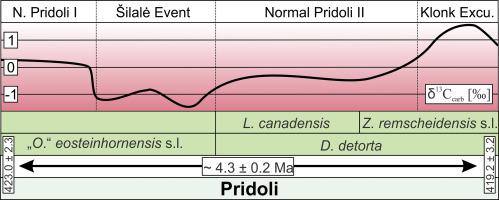当前位置:
X-MOL 学术
›
Gondwana Res.
›
论文详情
Our official English website, www.x-mol.net, welcomes your
feedback! (Note: you will need to create a separate account there.)
Ultra-high resolution multivariate record and multiscale causal analysis of Pridoli (late Silurian): implications for global stratigraphy, turnover events, and climate-biota interactions
Gondwana Research ( IF 7.2 ) Pub Date : 2020-10-01 , DOI: 10.1016/j.gr.2020.05.015 Andrej Spiridonov , Robertas Stankevič , Tomas Gečas , Antanas Brazauskas , Donatas Kaminskas , Petras Musteikis , Tomas Kaveckas , Tõnu Meidla , Giedrius Bičkauskas , Leho Ainsaar , Sigitas Radzevičius
Gondwana Research ( IF 7.2 ) Pub Date : 2020-10-01 , DOI: 10.1016/j.gr.2020.05.015 Andrej Spiridonov , Robertas Stankevič , Tomas Gečas , Antanas Brazauskas , Donatas Kaminskas , Petras Musteikis , Tomas Kaveckas , Tõnu Meidla , Giedrius Bičkauskas , Leho Ainsaar , Sigitas Radzevičius

|
Abstract The upper Silurian, and especially Pridoli epoch is a critical interval for the understanding the evolution of Earth’s biota, since it witnessed series of powerful extinction events, global reorganizations of paleocommunities, and expansion of new clades, which assumed dominance in the subsequent Devonian period. The stratigraphic record of the eastern part of the Silurian Baltic Basin represents an excellent candidate for the fine scale analysis of paleoecological and paleoceanographic dynamics. Therefore we presenting here stratigraphic record of the Milaiciai-103 core (south western Lithuania) of conodonts, brachiopods,δ13Ccarb, δ 18Ocarb and a series of various geochemical and geophysical proxies, most of which were sampled at a very high resolution (~ 11 Ka), spanning uppermost Ludlow, Pridoli, and the lowermost Devonian. The analysis revealed that the Pridoli was characterized by four distinct long-term dynamic states here named: i) Normal Pridoli I, ii) Silalė negative carbon isotopic excursion and extinction event, iii) Normal Pridoli II, and iv) Klonk positive stable carbon isotopic event and excursion. The most significant change in most variables is detected approximately in the middle of the Pridoli, at the beginning of the Delotaxis detorta Zone, at the recovery after Silalė event of conodonts, and at the onset of collapse of brachiopod communities. The analysis of dynamic complexity revealed the strong evidence for the presence of ~ 405 Ka metronome Milankovitch cycles in the record of δ13Ccarb, which constrains the duration of the Pridoli epoch to 4.3 ± 0.2 Ma. The recurrence plot analyses revealed deterministic coordination between δ13Ccarband conodont paleocommunity dynamics at all scales. Finally lead-lag analysis, using conditional joint recurrence, revealed that conodont dynamics, as a rule, were driven by perturbations in the carbon cycle, although Silalė event interval shown opposite pattern, thus confirming the unusual nature of this previously unrecognized coordinated climatic and biotic event.
中文翻译:

Pridoli(晚志留纪)的超高分辨率多变量记录和多尺度因果分析:对全球地层、周转事件和气候-生物群相互作用的影响
摘要 上志留纪,尤其是普里多利纪是理解地球生物群演化的关键时期,因为它见证了一系列强大的灭绝事件、古群落的全球重组和新进化枝的扩张,并在随后的泥盆纪占据主导地位。 . 志留纪波罗的海盆地东部的地层记录代表了对古生态和古海洋动力学进行精细尺度分析的极好候选者。因此,我们在此展示了 Milaiciai-103 核心(立陶宛西南部)的牙形石、腕足类、δ13Ccarb、δ18Ocarb 和一系列各种地球化学和地球物理代理的地层记录,其中大部分以非常高的分辨率(~11 Ka ),跨越最上层的 Ludlow、Pridoli 和最下层的泥盆纪。分析表明,Pridoli 具有四种不同的长期动态特征,此处命名为:i) 正常 Pridoli I,ii) Silalė 负碳同位素偏移和灭绝事件,iii) 正常 Pridoli II,以及 iv) Klonk 正稳定碳同位素活动和游览。大多数变量中最显着的变化大约发生在 Pridoli 的中部、Delotaxis detorta 区的开始、牙形石 Silalė 事件后的恢复以及腕足动物群落崩溃的开始。动态复杂性的分析揭示了δ13Ccarb 记录中存在~405 Ka 节拍器米兰科维奇循环的有力证据,这将 Pridoli 时代的持续时间限制在 4.3 ± 0.2 Ma。递归图分析揭示了 δ13Ccarband 牙形石古群落动力学在所有尺度上的确定性协调。最后,使用条件联合复发的超前滞后分析表明,牙形石动力学通常是由碳循环中的扰动驱动的,尽管 Silalė 事件间隔显示出相反的模式,从而证实了这种以前未被认识的协调气候和生物的不寻常性质事件。
更新日期:2020-10-01
中文翻译:

Pridoli(晚志留纪)的超高分辨率多变量记录和多尺度因果分析:对全球地层、周转事件和气候-生物群相互作用的影响
摘要 上志留纪,尤其是普里多利纪是理解地球生物群演化的关键时期,因为它见证了一系列强大的灭绝事件、古群落的全球重组和新进化枝的扩张,并在随后的泥盆纪占据主导地位。 . 志留纪波罗的海盆地东部的地层记录代表了对古生态和古海洋动力学进行精细尺度分析的极好候选者。因此,我们在此展示了 Milaiciai-103 核心(立陶宛西南部)的牙形石、腕足类、δ13Ccarb、δ18Ocarb 和一系列各种地球化学和地球物理代理的地层记录,其中大部分以非常高的分辨率(~11 Ka ),跨越最上层的 Ludlow、Pridoli 和最下层的泥盆纪。分析表明,Pridoli 具有四种不同的长期动态特征,此处命名为:i) 正常 Pridoli I,ii) Silalė 负碳同位素偏移和灭绝事件,iii) 正常 Pridoli II,以及 iv) Klonk 正稳定碳同位素活动和游览。大多数变量中最显着的变化大约发生在 Pridoli 的中部、Delotaxis detorta 区的开始、牙形石 Silalė 事件后的恢复以及腕足动物群落崩溃的开始。动态复杂性的分析揭示了δ13Ccarb 记录中存在~405 Ka 节拍器米兰科维奇循环的有力证据,这将 Pridoli 时代的持续时间限制在 4.3 ± 0.2 Ma。递归图分析揭示了 δ13Ccarband 牙形石古群落动力学在所有尺度上的确定性协调。最后,使用条件联合复发的超前滞后分析表明,牙形石动力学通常是由碳循环中的扰动驱动的,尽管 Silalė 事件间隔显示出相反的模式,从而证实了这种以前未被认识的协调气候和生物的不寻常性质事件。











































 京公网安备 11010802027423号
京公网安备 11010802027423号